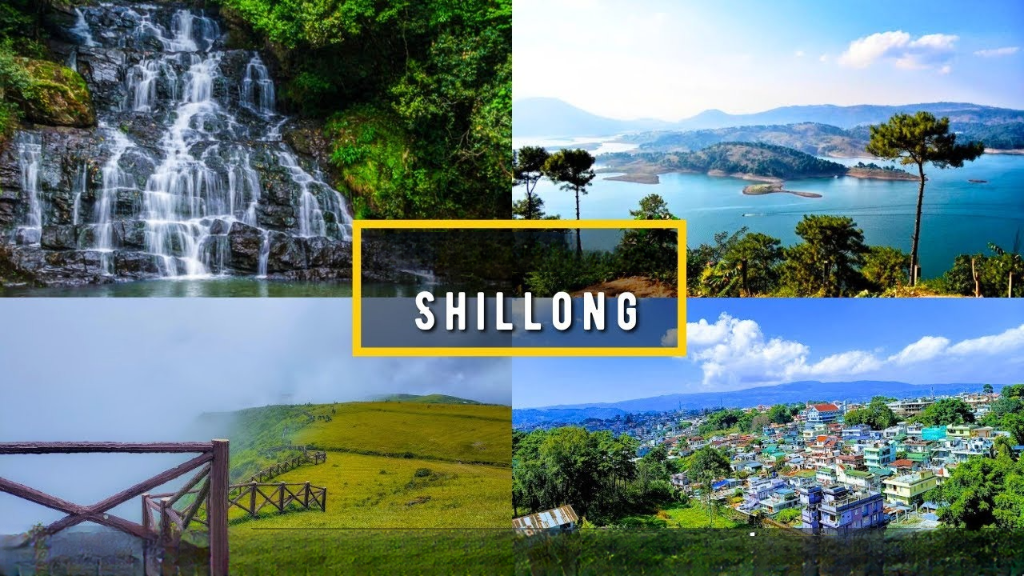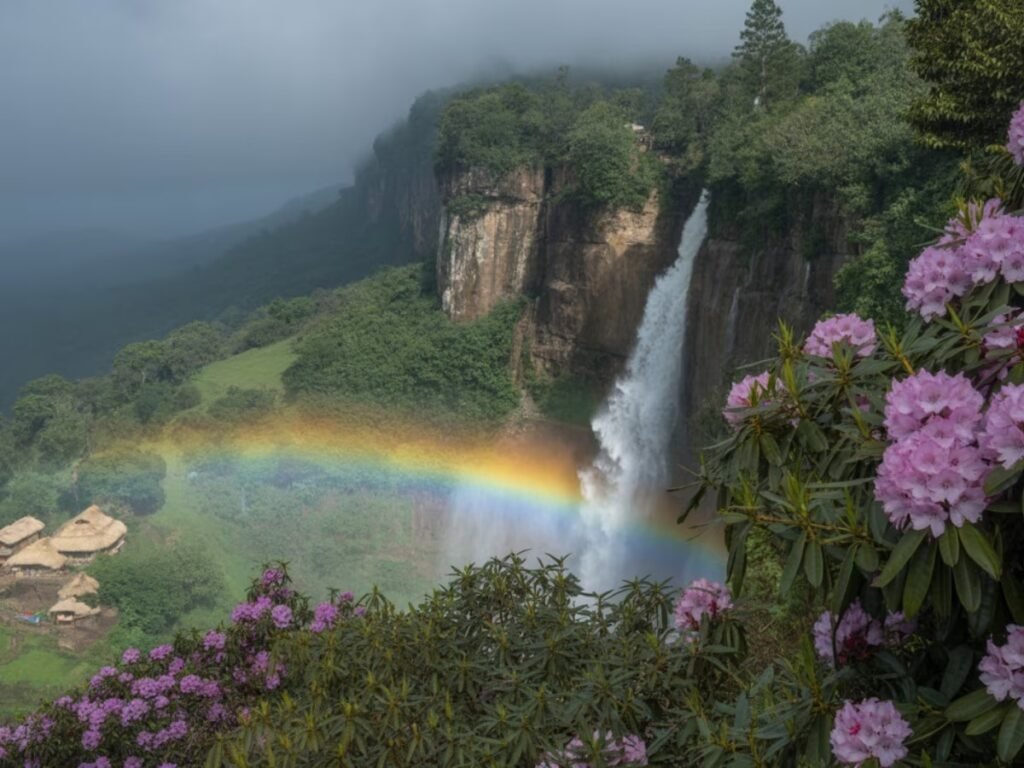Shillong, often referred to as the “Scotland of the East,” is the bustling capital of Meghalaya and a melting pot of culture, natural beauty, and heritage.
It is a beautiful high-altitude city in Northeast India, blending colonial architecture with indigenous Khasi traditions. The city sits on the lush Shillong Plateau, surrounded by dramatic hills and deep valleys, and is a favourite destination for nature enthusiasts, cultural travellers, and history buffs alike.
Location, Map, and Geographical Highlights
It is located at 25°34’N 91°53’E, on the Shillong Plateau, just 55 km from Mawsynram, the world’s wettest place. The city’s geography shapes its climate, biodiversity, and accessibility, making it unique among Indian cities.
Connectivity: How to Reach Shillong
It is accessible by road, air (limited flights), and via Guwahati’s rail and airport hubs.
- By Air: Umroi Airport is about 30 km away and has limited domestic connectivity; major flights operate from Guwahati.
- By Road: National highways connect Shillong to Guwahati, Silchar, Tripura, Mizoram, and North East towns. Taxis, private buses, and state buses operate daily.
- From Patna, take a train to Guwahati, then a taxi or bus to Shillong (~1,000 km, 14 hours by car).
The Shillong-Silchar highway provides an important transit route for trade and tourism, significantly reducing travel time between key cities.
Key Details:
- The best time to visit is from March to June for sightseeing and trekking, and from October to March for festivals and a cool climate.
- Budget travel: INR 4,000–8,000 for 4–5 days (excluding flight).
- Mid-range: INR 10,000–16,000 for 4–5 days (excluding flight).
- Luxury: INR 25,000+ for 4–5 days (including upscale hotels).
Historical Background
Its origins date back to the mid-19th century, when the British established it as a hill station for administrative convenience, drawn by the cool climate and strategic location. It became the capital of composite Assam and remained so until Meghalaya was carved out in 1972, with it continuing as the state capital. The name “Shillong” comes from the mythological deity U Shillong, whose abode is atop the city’s highest peak.
The great earthquake of 1897 razed much of old Shillong, but the city was rebuilt and continued to prosper. The post-independence years saw it emerge as a cosmopolitan hub, welcoming people from across India.
Culture and Heritage
It is truly multicultural, home to the Khasi, Garo, and Jaintia tribes, each with distinct traditions, festivals, and languages. The Khasi are the largest group, with matrilineal customs and grand celebrations such as Nongkrem Dance and Shad Suk Mynsiem, both vibrant displays of music, dance, and ritual.
Modern Shillong is India’s “Rock Capital,” renowned for its contemporary music festivals, including NH7 Weekender, a thriving local music scene, and numerous art and craft fairs. Traditional crafts such as bamboo and cane weaving remain popular, and the Jainsem, a flowing dress worn by Khasi women, symbolises local style.
Religious harmony is visible, with Christmas and Easter celebrated with as much fanfare as Diwali, Durga Puja, and Eid, reflecting the city’s pluralistic ethos.
Geography and Climate
Nestled in the East Khasi Hills, it lies at an elevation of approximately 1,495 meters (4,905 feet) and enjoys pleasant weather throughout the year. Summers are cool, rarely exceeding 23°C, while winters drop to 4°C, and the city receives reliable rainfall due to its proximity to Mawsynram, the world’s wettest place.
Shillong Peak towers above the city, offering panoramic vistas, while the lush plateaus and valleys make for breathtaking treks and drives.
Economic Overview and Revenue
As Meghalaya’s economic hub, it drives the region’s commerce, banking, tourism, and handicrafts. The state’s GSDP reached ₹52,974 crore (US$6.36 billion) in 2024-25, reflecting annual growth. Major industries include:
- Handlooms and handicrafts
- Agriculture and food processing
- Mining and cement production
- Tourism, which remains a key revenue generator
The city sees significant investment in roads, education, and small industries, though large-scale industrialisation is hampered by infrastructure challenges.
Tourist Attractions: Top Places to Visit
It is packed with scenic vistas, heritage sites, and family-friendly attractions.
| Place | Description | Distance from Centre |
|---|---|---|
| Shillong Peak | Highest point, panoramic views | ~10 km |
| Elephant Falls | Stunning multi-tiered waterfalls | ~12 km |
| Umiam Lake | Water sports and picnics | ~17 km |
| Ward’s Lake | Boating and flower beds | ~1 km |
| Laitlum Canyon | Panoramic views of valleys | ~23 km |
| Don Bosco Museum | NE India’s heritage and artifacts | ~4 km |
| Air Force Museum | Military history, aircraft display | ~12 km |
| Cathedral of Mary Help of Christians | Spiritual architecture | ~2 km |
| Shillong Golf Course | Oldest and largest in Asia | ~3 km |
| Mawphlang Sacred Forest | Ancient biodiversity, Khasi beliefs | nearby |
| Seven Sisters Falls | Majestic waterfall views | nearby |
A short drive opens further destinations like Cherrapunji’s caves and waterfalls, or Dawki’s crystal-clear river.
List of Must-Visit Places in Shillong
- Shillong Peak
- Elephant Falls
- Umiam Lake
- Ward’s Lake
- Laitlum Canyon
- Don Bosco Museum
- Air Force Museum
- Shillong Golf Course
- Cathedral of Mary Help of Christians
- Mawphlang Sacred Forest
- Seven Sisters Falls
- Nohkalikai Falls
- Nongjrong View Point
- Mawkdok Dympep Valley
- Mawsmai Cave
These locations blend natural beauty, adventure, spirituality, and history, symbolising its rich diversity.
Local Festivals and Events
Its festival calendar is packed with indigenous, cultural, and religious events.
- Cherry Blossom Festival: Celebrated in November, when Himalayan cherry trees bloom, accompanied by music, fashion shows, and cuisine stalls.
- Nongkrem Dance: A five-day Khasi harvest ritual in October-November.
- Shad Suk Mynsiem: Spring Thanksgiving festival.
- NH7 Weekender: Major music festival drawing national talent.
- Autumn Festival: Showcases local foods, wines, handicrafts, and more.
These festivals attract thousands of domestic and international tourists, boosting the local economy.

Shillong Teer: The Unique Archery Lottery
It is famous for “Shillong Teer,” a daily archery-based lottery game played at the Polo Grounds, operated by the Khasi Hills Archery Sports Association. Locals and tourists alike indulge in this blend of tradition and chance, with results announced twice daily, except Sundays.
Recent News
Recently, the traditional Shillong Teer archery festival has seen a surge in tourists, with the event boosting local business and drawing global visitors to the city’s unique blend of tradition and excitement. Organised by the Khasi Hills Archery Sports Association, the event has put it in global headlines for its cultural richness and community spirit.
FAQs About Shillong
What is the significance of Shillong’s name?
I am named after the local deity, U Shillong, believed to reside at Shillong Peak. The name also honours ancient legends and the spirituality of the Khasi people.
What is the best time to visit Shillong?
The city is ideal year-round, but spring (March–May) and autumn (October–November) are most pleasant, coinciding with major festivals and ideal weather conditions.
Which tribes live in Shillong?
The Khasi, Garo, and Jaintia are the main indigenous tribes, each with its own language, customs, and festivals.
What are the top tourist attractions in Shillong?
Highlights include Shillong Peak, Elephant Falls, Umiam Lake, Ward’s Lake, Don Bosco Museum, and Laitlum Canyon.
Is Shillong good for adventure tourism?
Yes, it offers a range of activities, including trekking, boating, caving, and nature walks, as well as scenic drives and panoramic sites that are ideal for adventure lovers.
How does Shillong generate revenue?
Tourism, handicrafts, agriculture, mining, and industry drive its economy, with tourism and the service sector seeing the fastest growth.
How can I reach Shillong from other parts of India?
The city is primarily accessible by road, with Guwahati serving as the main gateway via rail and air; It has a small domestic airport with limited flight options.
What is Shillong Teer?
Shillong Teer is a daily legal archery lottery and cultural event that forms a unique aspect of local tradition.
